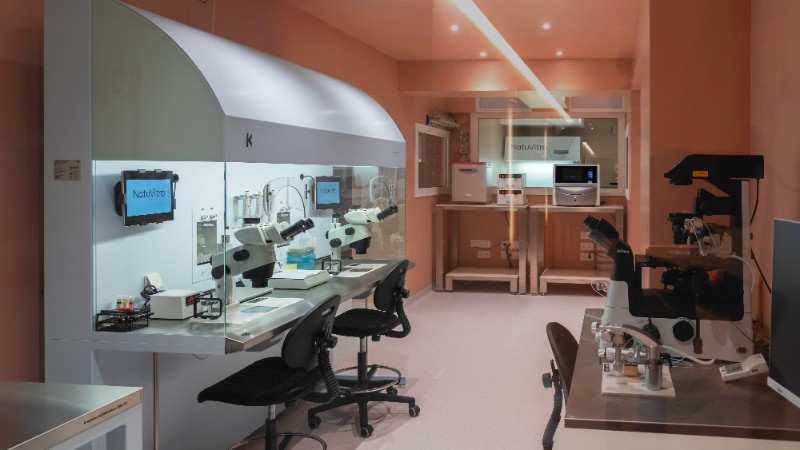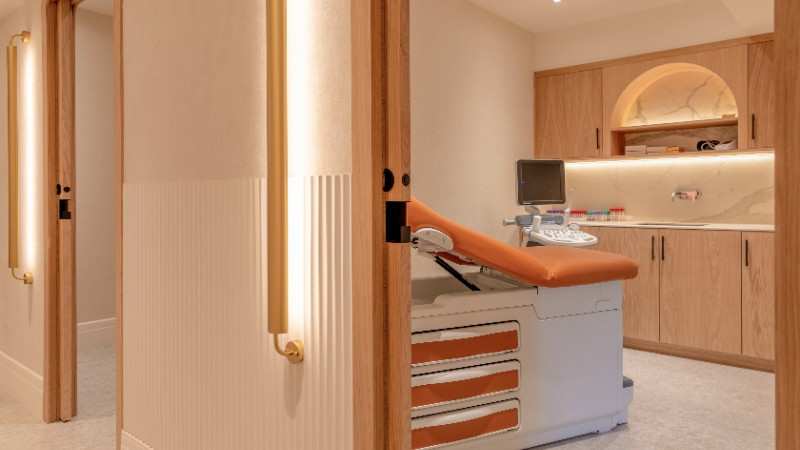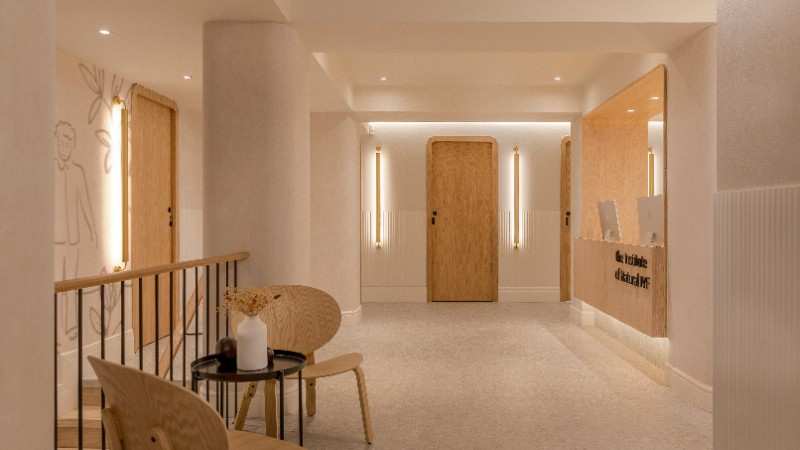
Between 20 and 30% of women have an anatomical variant called a retroverted uterus, characterized by a backward tilt of the uterus. It is important to note that this configuration is not considered a pathology and is generally painless, without having a significant impact on health. However, in certain situations, this particular position of the uterus may pose risks.
To understand the retroverted uterus, it is fundamental to know the normal functioning of this organ as well as the different positions it can adopt.
Although this anatomical variation may not have adverse effects on general health, doubts remain regarding its possible impact on fertility and pregnancy.
This text explores in detail the aspects of the retroverted uterus, covering its symptoms, diagnostic methods, and its possible influence on motherhood. Discover everything you need to know about this anatomical variant to better understand its potential implications.
What is the uterus and how does it work?
The uterus, a hollow organ of the female reproductive system, acts as the "sac" that houses the embryo and supports the growth of the fetus. Located in the pelvis, between the bladder and the rectum, it takes the shape of a cone directed towards the cervix and the vagina. The uterine horns, an extension of its upper part, lead to the fallopian tubes, which in turn open into the ovaries. Held in the pelvis by round and uterosacral ligaments, elevating muscles, and pelvic floor muscles (perineum), the uterus is surrounded by a smooth muscle called the myometrium. This muscle contracts during childbirth, facilitating the expulsion of the baby.
Inside, the uterus is lined by a membrane called the endometrium, which thickens under the influence of hormones (estrogen) during the menstrual cycle. In the absence of fertilization, this membrane is shed through the vagina during menstruation. In the case of fertilization, the uterus, which normally measures 8 cm by 4 cm, expands up to 35 cm to accommodate the size of the fetus during pregnancy, returning to its usual dimensions about two months after childbirth.
The positions of the uterus vary
In most cases (70 to 80%), it is in anteversion and anteflexion, resting on the bladder. In 20 to 30% of cases, it is retroverted, tilted backward and pressed against the rectum. This retroversion is generally not problematic for pregnancy. It can also change position depending on the filling of the rectum or bladder.
The retroversion of the uterus, which affects between 20 and 30% of women, is not considered a pathology, but rather a normal anatomical feature without major implications. To date, there is no evidence suggesting that this feature is hereditary.
The characteristics of the retroverted uterus
The backward tilt of the uterus towards the rectum can be congenital, existing from birth, or secondary, resulting for example from childbirth with obstetric tearing or stretching of the uterine ligaments. It may also be related to certain pelvic pathologies. The presence of a mass such as a fibroid or uterine polyp, particularly in women over 40, may explain the backward push of the uterus. Similarly, a retroverted uterus may result from an inflammatory disease such as endometriosis.
Risk factors
Although this configuration of the uterus is generally present from birth, it can also occur due to various factors such as a previous abortion, surgery, an inflammatory process, or develop gradually in excessively thin women.
Symptoms of a retroverted uterus.
The symptoms associated with a retroverted uterus can vary, although in most cases, it does not have a significant impact on a woman's fertility, health, and pregnancy. However, it can sometimes cause debilitating symptoms, such as more frequent pelvic and sacro-lumbar pain before and during menstruation (dysmenorrhea), pain during sexual intercourse (dyspareunia), constipation, pain during defecation, urinary difficulties, or frequent urges to urinate. An increased risk of pelvic organ prolapse, known as organ descent, may also be associated with this condition. Surgical intervention is only considered in cases of very intense pain.
Diagnosis of the retroverted uterus
Women with a retroverted uterus generally show no particular signs. The discovery of the retroversion of the uterus often occurs incidentally during a routine gynecological examination, such as an ultrasound (a painless and non-radiating examination most often prescribed), an MRI (used in case of certain pathologies like endometriosis), a CT scan, exploration, or hysteroscopy (which allows direct examination of the uterine cavity and endometrium through fiber optics).
Consequences of a retroverted uterus
In the case of the simple anatomical variant, the retroverted uterus does not hinder the access of sperm to the egg and does not obstruct the progress of pregnancy in any way. Its displaced position is not a barrier to assisted reproductive treatments either. Only associated pathologies may cause infertility issues.
In most cases, in the absence of symptoms and consequences, women with a retroverted uterus do not require any specific treatment.
Treatment of the retroverted uterus
Treatment may be considered if the pain caused by the retroverted uterus proves to be debilitating. A pessary test may be performed to confirm the link between the pain felt and the retroversion of the uterus. The pessary, a flexible ring made of rubber, latex, or silicone, is inserted into the vagina to fix or limit the movement of the cervix and support the uterus, partially correcting the retroversion. The device is left in place for a few days or even a few weeks. If the test is positive (i.e., the pain is relieved), the causal link between the pain and the retroverted uterus is confirmed, and surgical intervention may be considered. Patients with a retroverted uterus may access various assisted reproductive techniques, such as artificial insemination, IVF with or without ICSI, the ROPA method, or egg donation.
Pregnancy with a retroverted uterus
In most cases, a retroverted uterus generally has no impact on the course of pregnancy.
However, it is possible to experience pain during the first trimester, explained by the gradual and spontaneous straightening of the uterus between the twelfth and fourteenth week. With the increase in uterine volume, it naturally straightens and moves to an anteverted position.
If the uterus does not straighten spontaneously beyond the first trimester, a vaginal maneuver may be necessary to avoid any risk of blockage in the small pelvis. This procedure aimed at orienting the uterus into an anteverted position is generally performed under general anesthesia.
On the other hand, a retroverted uterus generally does not pose a problem for the insertion of an IUD. However, if the tilt of the uterus is due to a uterine pathology, this form of contraception may not be recommended. Indeed, intrauterine devices (IUDs) can increase the duration of periods and the amount of bleeding, making them contraindicated in cases of endometriosis or fibroids. In any case, to obtain an accurate diagnosis of the uterus and avoid complications, it is advisable to perform an ultrasound before introducing the IUD.
If you are experiencing difficulties related to a retroverted uterus or have questions about pregnancy, fertility, or assisted reproductive methods, feel free to contact us. At NatuVitro, our team of specialists will guide you and provide you with the information you need. We understand the importance of each individual journey and are committed to offering personalized support. Contact us today to fully understand your situation and explore your options.
Our experts are ready to examine your case history, clarify your choices, and address every question you have.
Don't wait to make informed decisions – your personalized guidance awaits!
- Spain (España)+34
- France (La France)+33
- Italy (Italia)+39
- United Kingdom+44
- United States+1
- Belgium (België)+32
- Switzerland (Schweiz/Suisse)+41
- Germany (Deutschland)+49
- Netherlands (Nederland)+31
- Afghanistan (افغانستان)+93
- Albania (Shqipëri)+355
- Algeria (الجزائر)+213
- American Samoa+1
- Andorra+376
- Angola+244
- Anguilla+1
- Antigua and Barbuda+1
- Argentina+54
- Armenia (Հայաստան)+374
- Aruba+297
- Ascension Island+247
- Australia+61
- Austria (Österreich)+43
- Azerbaijan (Azərbaycan)+994
- Bahamas+1
- Bahrain (البحرين)+973
- Bangladesh (বাংলাদেশ)+880
- Barbados+1
- Belarus (Беларусь)+375
- Belize+501
- Benin (Bénin)+229
- Bermuda+1
- Bhutan (འབྲུག)+975
- Bolivia+591
- Bosnia and Herzegovina (Босна и Херцеговина)+387
- Botswana+267
- Brazil (Brasil)+55
- British Indian Ocean Territory+246
- British Virgin Islands+1
- Brunei+673
- Bulgaria (България)+359
- Burkina Faso+226
- Burundi (Uburundi)+257
- Cambodia (កម្ពុជា)+855
- Cameroon (Cameroun)+237
- Canada+1
- Cape Verde (Kabu Verdi)+238
- Caribbean Netherlands+599
- Cayman Islands+1
- Central African Republic (République centrafricaine)+236
- Chad (Tchad)+235
- Chile+56
- China (中国)+86
- Christmas Island+61
- Cocos (Keeling) Islands+61
- Colombia+57
- Comoros (جزر القمر)+269
- Congo (DRC) (Jamhuri ya Kidemokrasia ya Kongo)+243
- Congo (Republic) (Congo-Brazzaville)+242
- Cook Islands+682
- Costa Rica+506
- Côte d’Ivoire+225
- Croatia (Hrvatska)+385
- Cuba+53
- Curaçao+599
- Cyprus (Κύπρος)+357
- Czech Republic (Česká republika)+420
- Denmark (Danmark)+45
- Djibouti+253
- Dominica+1
- Dominican Republic (República Dominicana)+1
- Ecuador+593
- Egypt (مصر)+20
- El Salvador+503
- Equatorial Guinea (Guinea Ecuatorial)+240
- Eritrea+291
- Estonia (Eesti)+372
- Eswatini+268
- Ethiopia+251
- Falkland Islands (Islas Malvinas)+500
- Faroe Islands (Føroyar)+298
- Fiji+679
- Finland (Suomi)+358
- French Guiana (Guyane française)+594
- French Polynesia (Polynésie française)+689
- Gabon+241
- Gambia+220
- Georgia (საქართველო)+995
- Ghana (Gaana)+233
- Gibraltar+350
- Greece (Ελλάδα)+30
- Greenland (Kalaallit Nunaat)+299
- Grenada+1
- Guadeloupe+590
- Guam+1
- Guatemala+502
- Guernsey+44
- Guinea (Guinée)+224
- Guinea-Bissau (Guiné Bissau)+245
- Guyana+592
- Haiti+509
- Honduras+504
- Hong Kong (香港)+852
- Hungary (Magyarország)+36
- Iceland (Ísland)+354
- India (भारत)+91
- Indonesia+62
- Iran (ایران)+98
- Iraq (العراق)+964
- Ireland+353
- Isle of Man+44
- Israel (ישראל)+972
- Italy (Italia)+39
- Jamaica+1
- Japan (日本)+81
- Jersey+44
- Jordan (الأردن)+962
- Kazakhstan (Казахстан)+7
- Kenya+254
- Kiribati+686
- Kosovo+383
- Kuwait (الكويت)+965
- Kyrgyzstan (Кыргызстан)+996
- Laos (ລາວ)+856
- Latvia (Latvija)+371
- Lebanon (لبنان)+961
- Lesotho+266
- Liberia+231
- Libya (ليبيا)+218
- Liechtenstein+423
- Lithuania (Lietuva)+370
- Luxembourg+352
- Macau (澳門)+853
- North Macedonia (Македонија)+389
- Madagascar (Madagasikara)+261
- Malawi+265
- Malaysia+60
- Maldives+960
- Mali+223
- Malta+356
- Marshall Islands+692
- Martinique+596
- Mauritania (موريتانيا)+222
- Mauritius (Moris)+230
- Mayotte+262
- Mexico (México)+52
- Micronesia+691
- Moldova (Republica Moldova)+373
- Monaco+377
- Mongolia (Монгол)+976
- Montenegro (Crna Gora)+382
- Montserrat+1
- Morocco (المغرب)+212
- Mozambique (Moçambique)+258
- Myanmar (Burma) (မြန်မာ)+95
- Namibia (Namibië)+264
- Nauru+674
- Nepal (नेपाल)+977
- New Caledonia (Nouvelle-Calédonie)+687
- New Zealand+64
- Nicaragua+505
- Niger (Nijar)+227
- Nigeria+234
- Niue+683
- Norfolk Island+672
- North Korea (조선 민주주의 인민 공화국)+850
- Northern Mariana Islands+1
- Norway (Norge)+47
- Oman (عُمان)+968
- Pakistan (پاکستان)+92
- Palau+680
- Palestine (فلسطين)+970
- Panama (Panamá)+507
- Papua New Guinea+675
- Paraguay+595
- Peru (Perú)+51
- Philippines+63
- Poland (Polska)+48
- Portugal+351
- Puerto Rico+1
- Qatar (قطر)+974
- Réunion (La Réunion)+262
- Romania (România)+40
- Russia (Россия)+7
- Rwanda+250
- Saint Barthélemy+590
- Saint Helena+290
- Saint Kitts and Nevis+1
- Saint Lucia+1
- Saint Martin (Saint-Martin (partie française))+590
- Saint Pierre and Miquelon (Saint-Pierre-et-Miquelon)+508
- Saint Vincent and the Grenadines+1
- Samoa+685
- San Marino+378
- São Tomé and Príncipe (São Tomé e Príncipe)+239
- Saudi Arabia (المملكة العربية السعودية)+966
- Senegal (Sénégal)+221
- Serbia (Србија)+381
- Seychelles+248
- Sierra Leone+232
- Singapore+65
- Sint Maarten+1
- Slovakia (Slovensko)+421
- Slovenia (Slovenija)+386
- Solomon Islands+677
- Somalia (Soomaaliya)+252
- South Africa+27
- South Korea (대한민국)+82
- South Sudan (جنوب السودان)+211
- Spain (España)+34
- Sri Lanka (ශ්රී ලංකාව)+94
- Sudan (السودان)+249
- Suriname+597
- Svalbard and Jan Mayen+47
- Sweden (Sverige)+46
- Syria (سوريا)+963
- Taiwan (台灣)+886
- Tajikistan+992
- Tanzania+255
- Thailand (ไทย)+66
- Timor-Leste+670
- Togo+228
- Tokelau+690
- Tonga+676
- Trinidad and Tobago+1
- Tunisia (تونس)+216
- Turkey (Türkiye)+90
- Turkmenistan+993
- Turks and Caicos Islands+1
- Tuvalu+688
- U.S. Virgin Islands+1
- Uganda+256
- Ukraine (Україна)+380
- United Arab Emirates (الإمارات العربية المتحدة)+971
- Uruguay+598
- Uzbekistan (Oʻzbekiston)+998
- Vanuatu+678
- Vatican City (Città del Vaticano)+39
- Venezuela+58
- Vietnam (Việt Nam)+84
- Wallis and Futuna (Wallis-et-Futuna)+681
- Western Sahara (الصحراء الغربية)+212
- Yemen (اليمن)+967
- Zambia+260
- Zimbabwe+263
- Åland Islands+358
Visit our clinic
Location
Call us now
Leave a message








